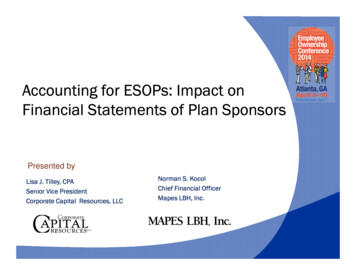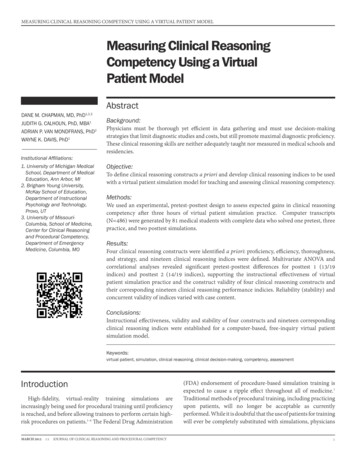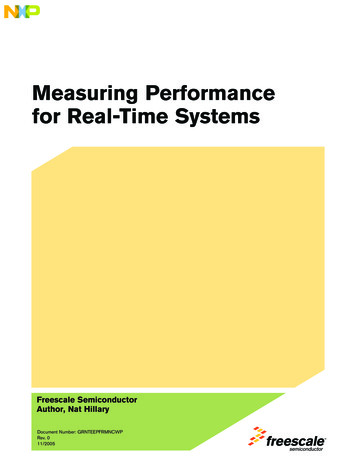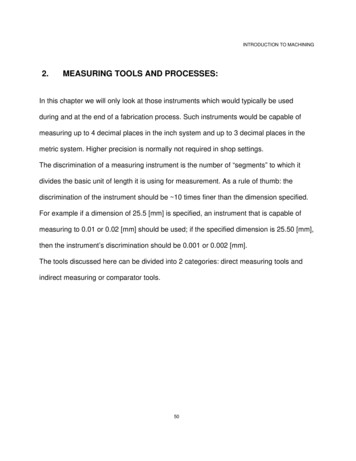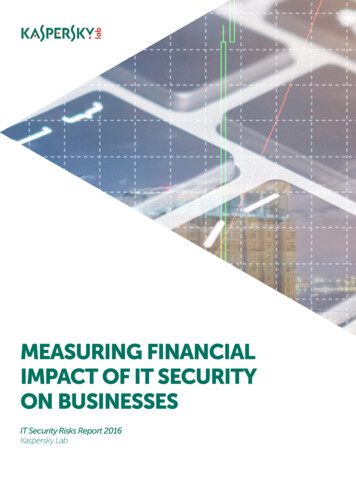
Transcription
MEASURING FINANCIALIMPACT OF IT SECURITYON BUSINESSESIT Security Risks Report 2016Kaspersky Lab
MEASURING FINANCIAL IMPACTOF IT SECURITY ON BUSINESSESCONTENTINTRODUCTION.3INVESTIGATING REASONS BEHIND SECURITY SPENDING. 4MEASURING FINANCIAL IMPACT OF SECURITY BREACHES. 6SECURITY IS TOUGH TO MASTER. 8CONCLUSION.112
MEASURING FINANCIAL IMPACTOF IT SECURITY ON BUSINESSESINTRODUCTIONAs cyber threats against businesses of all shapes and sizes continue tobecome more sophisticated and prevalent, IT security spend and resourcesare being more heavily scrutinized and relied upon to protect organizationsfrom attack. Increases in BYOD and mainstream IoT adoption in recent yearshave also added to the complexity of locking down the IT environment,and opened up even more avenues for cybercriminals to exploit individualsand businesses through system and human vulnerabilities.With so much reliance on technology for businesses to function andremain competitive, do the economics of budgets set aside to safeguardbusinesses and the potential financial losses caused by a security incidentstack up? To find out, Kaspersky Lab together with B2B International,conducted a global study of more than 4,000 business representativesfrom 25 countries, looking at their IT security budgets, the complexity oftheir infrastructure, attitudes towards security threats and solutions, andthe real cost of data breaches and security incidents experienced.Whilst the research revealed that budgets for IT security are set to grow by14% over the next 3 years, this still only accounts for a small proportion ofthe overall IT budget. So what does this mean in practice and is it enoughto safeguard businesses against the very real threats which affect themtoday (and tomorrow)?3
MEASURING FINANCIAL IMPACTOF IT SECURITY ON BUSINESSESINVESTIGATING REASONS BEHIND SECURITYSPENDINGThere is no denying that IT security is becoming a key priority for businesses,as the reliance on and complex nature of technology continues to grow.Indeed, for enterprises, the increased complexity of IT infrastructure wasthe number one driver for wanting to increase IT security spend (48%). 42%of SMBs agreed, with only a quarter (24%) of VSBs seeing complexity as themain reason for increasing budgets, citing new business activities/expansionas the top reason (35%).Despite finding it difficult to demonstrate the ROI of investments in ITsecurity to senior management, businesses of all sizes agree that they willcontinue to invest in improving IT security regardless of ROI, as it is better tobe safe than sorry.44%62%59%Share of businesses agreeing that they will invest in improving our ITsecurity regardless of the ROI.Indeed, many businesses find it difficult to demonstrate effectivenessof IT security investment to top management. Among enterprises, 51%agreed with this statement and 49% of small and medium businesses alsoexperience difficulties. One of the key findings of the 2016 IT Security Riskssurvey is that security remains to be a contradicting topic when it comes tobudget. On the one hand, the importance of protecting business data fromcyber threats is understood universally. On the other, IT spending, measuredboth relatively and absolutely, is still low for many industries and companiesof all sizes.Currently, businesses only allocate about 17% of their IT budget to security,with VSBs proportioning a significantly smaller amount than enterprises(13% vs 21%).IT security budget figuresVSBSMBEnterprises% of IT Budget Spent on IT Security13%18%21%Average IT Security Budget 2k 213k 25.5m 12.5% 14.3% 14.4%Expected Growth of IT Security Budget (Over 3yrs)4
MEASURING FINANCIAL IMPACTOF IT SECURITY ON BUSINESSESIn monetary terms, two-thirds (66%) of VSBs spend less than 1,000 a yearon IT security compared to 68% of enterprises who spend over 1 million.% of Businesses Whose IT Security Budget Falls Into Each CategoryWhen drilling down into different industries, there is also huge variation inbudgets. As we see, IT budgets depend on company size, but we found away to compare different sizes of business by calculating annual investmentper IT security specialist.IndustryAvg. ITSecurity Spendper IT expertDefence 2,369High IPFinancial Transportation HospitalityManufacturing Services& Logistics& Leisure 2,255 2,008 380 318Although there is a desire and clear, key drivers to increase budgets in thisarea, the predicted rise in IT security spending is a modest 14%. Looking atspecific budgets for staff resources to tackle the problem the same story istrue, with ambition not necessarily backed up by action.Despite a predicted rise in the number of dedicated IT security specialistsover the next 3 years (22% of SMBs expect the number to rise significantly),the money to pay for this is seemingly not available or forthcoming, withonly 10% of organizations expecting the proportion of IT security budgetspent on wages will increase accordingly.5
MEASURING FINANCIAL IMPACTOF IT SECURITY ON BUSINESSESMEASURING FINANCIAL IMPACT OF SECURITYBREACHESSo with IT security expectations often failing to materialize, will the realcost of a security incident give businesses the wake-up call they need toreassess IT security spending and ensure that available budgets are beingallocated in the right way?For most businesses, spending on IT security can be a mere drop in theocean when compared to the actual cost to a business of a securityincident or data breach. The impact is felt not just in financial terms butthrough reputational damage, which could affect the long-term prosperityand success of a business.With over half (52%) of all businesses assuming that their IT security will becompromised at some point, being prepared and using budgets to besteffect is essential. Over the past 12 months alone, over a third of businesses(38%) have been affected by viruses and malware causing a loss ofproductivity, and experienced inappropriate IT resource use by employees(36%). One in five (21%) has experienced data loss or exposure due totargeted attacks.Types of security event experienced in the past 12 months(% of all businesses experiencing each type of attack)Whilst these figures alone provide good evidence to support increasedspend and resource on cyber threat prevention and recovery, it is onlywhen faced with the real costs of these types of incidents does it put it intoclear perspective.6
MEASURING FINANCIAL IMPACTOF IT SECURITY ON BUSINESSESFor all of the incidents experienced by businesses, almost half (43%) resultedin a data breach, loss or exposure of some kind. Putting this into context,the average financial impact of a single data breach and attack vector foran SMB is an estimated 86.5k and for enterprises a staggering 861k. Thereallocation of IT staff time represents the single largest additional cost forboth SMBs and enterprises within this estimate.The breakdown of an average financial impact of a data breachSMBEnterprise7
MEASURING FINANCIAL IMPACTOF IT SECURITY ON BUSINESSESBut this is just the average across a range of attack vectors, with sometypes of attacks costing a business more. Previously unknown “zero” dayvulnerabilities – whilst rare - have cost SMBs an estimated 149k andenterprises 2m, with targeted attacks resulting in a financial impact of 143k and 1.7m respectively. Where multiple attacks are coordinated andcomprise more than one vector, businesses can be hit even harder. This isespecially true for enterprise-level organizations whose total financialimpact for an attack consisting of three or more vectors is estimated to be 1.7m (compared to 117k for SMBs).Top ten most ‘expensive’ security incidents for SMBsTop ten most ‘expensive’ security incidents for enterprise8
MEASURING FINANCIAL IMPACTOF IT SECURITY ON BUSINESSESIn all cases, the financial impact has been seen to increase with time, withrapid detection of a data breach a key factor in minimizing not only dataloss but the financial cost to the business. The longer a breach goesunnoticed, the more it will cost a business in monetary and data integrityterms. Even when breaches are detected almost instantly, SMBs estimatea cost to their business of 28k, rising to 105k if undetected for more thana week. For enterprises, where a detection system is in place the estimatedfinancial damage is still 393k, increasing to over 1m if it remainsundetected for over 7 days.Cost of recovery vs. time needed to discover a security breach, for SMBsCost of recovery vs. time needed to discover a security breach forenterprisesData itself is also more vulnerable the longer a breach goes unnoticed, withan average of 417 sensitive customer/employee records compromised perincident - even with instant detection - and over 70k at risk if undetectedfor more than a week.9
MEASURING FINANCIAL IMPACTOF IT SECURITY ON BUSINESSESWhen we compare the average annual IT security spend of SMB andenterprise businesses with the estimated losses of just a single attack,we start to get a real sense and scale of just how tight budgets are andthat there is little room for error in how the budget is allocated. Takingthe average SMB IT security spend of 213k, and comparing it with theaverage cost of an attack ( 86.5k), SMB IT security provisions only need toprevent 2.5 attacks before they are saving the business significant funds,not to mention reputational damage.With businesses aware of network vulnerabilities and expecting them to beexploited, the prevalence and success of cyber attacks against businessesis only going to rise. But with IT security budgets only set for a modestincrease over the next few years, the financial impact could become evenmore severe.10
MEASURING FINANCIAL IMPACTOF IT SECURITY ON BUSINESSESCONCLUSIONWhilst cyber attacks are inevitable, the way businesses use availablebudgets and resource will be vital in the coming years, in keeping thefinancial (and reputational) impact down. Whilst losses will occur asa result, the key is to minimize them. This is our aim and on average,Kaspersky Lab customers who do suffer a breach experience muchless severe financial consequences than our competitors – 30% lessfor SMBs and 18% less for enterprise customers.The financial impact can only be curbed by taking a holistic approachto IT security instead of relying just on detection technology to dothe job. It is encouraging to see that 45% of companies believe thathardware and software alone won’t necessarily solve all IT securityincidents. But although this is the case, it is not necessarily backedup by the right resources to provide total protection – with 73% stillbelieving that workstation security software alone is effective.As evidenced in the research, education of employees should form akey part of a company’s arsenal in minimizing the likelihood of cyberattack. With careless employees the second biggest cause of securityincident in the past 12 months and the single biggest cause of seriousincidents involving data loss or leakage, training and education oncyber threats is vital to creating a savvier and less vulnerable workforce.Alongside detection technology, clued up and vigilant staff who aremore informed and aware of the risks facing businesses today andtomorrow will help improve detection and minimize impact. However,when assessing where security budgets are to be spent, there isa general reluctance on the part of businesses to accept outsidehelp – with only 18% of organizations considering better insights andintelligence on threats as a top method to improve detection.Despite this feeling, without the benefit of insight and intelligence,organizations will remain unable to improve detection and combatthe growing number and severity of cyber threats. Only by movingbeyond prevention towards recovery and mitigation will organizationsbe able to reduce their risk and the inevitable financial consequencesof a cyber attack.11
MEASURING FINANCIAL IMPACTOF IT SECURITY ON BUSINESSESSecurelist, the resourcefor Kaspersky Lab experts’technical research,analysis, and thoughts.12Follow usKaspersky Lab global WebsiteEugene Kaspersky BlogKaspersky Lab B2C BlogKaspersky Lab B2B BlogKaspersky Lab security news serviceKaspersky Lab Academy
experience difficulties. One of the key findings of the 2016 IT Security Risks survey is that security remains to be a contradicting topic when it comes to budget. On the one hand, the importance of protecting business data from cyber threats is understood




